Amazon aggregators are a profitable exit strategy for Fulfillment by Amazon (or FBA) businesses and have become increasingly popular over the last few years. (In fact, of the 19 ecommerce acquisition companies on this list, 11 of them were launched within the last year.)
All of these aggregators have capital to spend and they are currently searching for successful ecommerce brands and products on Amazon to invest in. In May, Perch announced its $775M Series A investment; Foundry Brands has $100M in debt-free equity capital to invest; Boosted Commerce has raised $380M in capital; and Intrinsic has raised $113M in Series A funding. The funding available among all of the companies highlighted in this article is more than $3.4 billion.
If you are an Amazon seller who is looking for an exit from your business, you should get to know the big names in the Amazon rollup space. Keep reading to discover who the top Amazon brand aggregators are, what they’re looking for in potential investments, what their acquisition process looks like, and a few exclusive tips directly from the aggregators.
What is an Amazon Aggregator?
Amazon aggregators acquire and incubate ecommerce brands through innovative partnerships with entrepreneurs, with the goal to scale the acquired Amazon brands and gain revenue for their investors. Aggregators seek out Amazon sellers they deem have great sales potential so they can consolidate and operate a portfolio of ecommerce businesses.
In many cases, FBA business owners earn multiple years’ worth of profit when they sell their business to an aggregator. So if you feel like it’s time to move on to your next big venture, selling your FBA business to an Amazon aggregator is a great way to secure the seed capital you’ll need for your new journey.
Who can sell their Amazon business?
Due to advantages in the marketplace, certain types of Amazon businesses are more appealing to aggregators than others. The three most common types of FBA businesses include wholesale, private label, and proprietary products.
Private label is the process of a retailer rebranding/renaming a product that is already being manufactured on their own brand or label. Wholesaling is the practice of purchasing low-cost or discounted goods in bulk in order to sell as individual units in a retail marketplace. Often, the wholesale products already have listings created on Amazon. Proprietary products are exclusively owned by the company or person selling them on Amazon. These products are often protected by patent, trademark or copyright.
Private label brands are more likely to get acquired than wholesalers, even if their products can be purchased from another seller, because aggregators look for Amazon businesses with solid sales history and brand recognition. Aggregators are also attracted to proprietary products that have strong profits and good reviews, as they know customers can’t get these products elsewhere.
If you own a private label brand or have a proprietary product that is successful on Amazon and you are looking for an exit, brand acquisition might be right for you.
According to Greg Elfrink from Empire Flippers, “Once you get into the $800,000 to $1 million+ valuation range, that’s when you get to benefit the most from the activity of all the aggregators and ultra-high networth individuals acquiring FBA businesses.”
With that in mind, the best time to sell your Amazon business is while you’re turning a healthy profit. When you are on an upswing in sales you will have more negotiating power during the acquisition. Showing healthy sales will also open the door to discussions with more aggregators so that you can find the right fit for you.
To learn more about whether or not your Amazon business is ready for an acquisition read Jungle Scout’s How to Sell Your Amazon Business in 2021.
Can I stay with my brand post-acquisition?
Depending on the terms of the agreement, Amazon aggregators may allow founders to stay on board and continue to be a part of the growth and success of their brand. Or, they may hire talented brand owners to their staff to help develop other acquired brands.
Remaining part of your brand post-acquisition can be beneficial because many aggregators are able to significantly grow their acquired brands’ revenue. Elevate Brands has grown earnings for their acquired brands by 95%+ by the end of the first year of ownership and Acquco’s portfolio of brands combined is generating $200M+ annual revenue.
5 tips for selling your Amazon business
Planning an exit strategy from your Amazon business can be a confusing and intimidating process. It requires careful deliberation and research to make an informed decision that is best for you and your company. Check out our guide on How to Sell Your Amazon Business, and a few tips directly from Amazon aggregators for sellers who are considering a business exit:
1. Explore your options
Given the importance of a potential exit, Foundry Brands highly recommends talking to several acquisition companies as part of your process. Kyle Walker, Chief Acquisition Officer at Foundry Brands said, “We view our job as educators and our team is always available to help advise and share insights from the industry to ensure you get the right deal for you.”
2. Ask questions
When choosing a buyer for your brand, there are several considerations beyond the upfront cash payment. Yadin Shemmer, CEO of Intrinsic, suggests that you ask yourself these questions:
- “Who is most likely to succeed with my brand and carry on its legacy?”
- “Who is most likely to achieve and pay an earn-out?”
- “Who can best help me find and grow my next business?”
3. Get a valuation
Reach out to an aggregator to learn about the process and get a valuation of your business. Companies such as SellerX are happy to offer free valuations and exit planning advice for your business, even if you aren’t looking to sell anytime soon.
4. Use caution
Don’t enter into the Letter of Intent (LOI) phase until you are ready. Nathan Sieminski, Marketing Manager at Perch, warns that, “While under LOI, a seller is under exclusivity, so they can’t shop the deal around unless it falls through.”
5. Don’t sell until you’re ready
Greg Elfrink, Director of Marketing at Empire Flippers, warns Amazon sellers not to sell their businesses simply because their valuations are high. “There are tons of buyers waiting to acquire you. You should never try to time the market. Instead, you should only sell your FBA business if the capital you can get will truly help you reach your personal and business goals you’ve set for yourself.”
Amazon Aggregators: 19 Options for Selling Your Brand
1. Perch
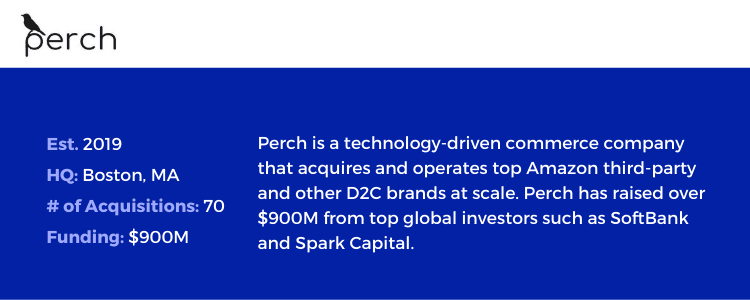
What is Perch looking for?
Perch is broadly category agnostic, they look for high-quality products and brands that have a steady history of strong customer reviews and are consistently one of the top three products within their category. Their portfolio consists of products in home & kitchen, apparel & beauty, health & wellness, toys, and more. They seek brands with a minimum revenue of $1M or roughly $200k seller’s discretionary earnings (SDE).
What does Perch’s acquisition process look like?
If your brand matches Perch’s criteria and you would like to explore a sale, you can reach out to them and they will request a storefront URL and other basic information. If Perch believes there is a fit, they will send over an non-disclosure agreement (NDA) before going over your brand’s profit and loss (P&L) statement and submitting a Letter of Intent (LOI) that summarizes the terms of the deal.
The brand will then move into a due diligence process of several weeks that will confirm that all business’ numbers were accurately represented so that Perch can arrive at the final valuation and provide the offer. They generally close most deals within 30 days. However, for larger and more complex businesses that own multiple brands, warehouses, and have dozens of employees, it will require 2-3 months for due diligence before closing.
Brands can expect most or all of their cash to come at close, with some deals including an element of an earnout, stability payment, or profit-share that will be paid out after the brand reaches certain milestones over the course of the next several years.
If you would like to learn more, you can visit the Perch website and fill their contact form.
2. Boosted Commerce
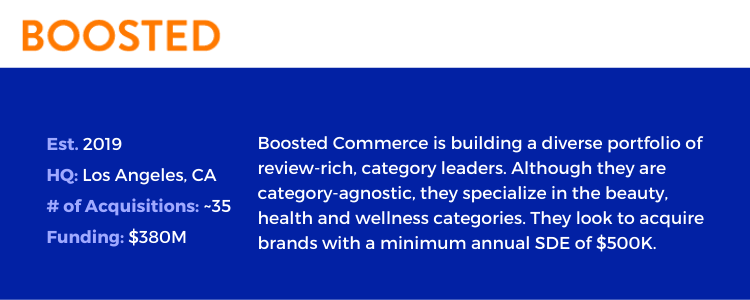
What is Boosted Commerce looking for?
Boosted Commerce considers themselves category agnostic outside of electronics and apparel. They look to acquire brands with a minimum annual SDE of $500K, with a current sweet spot up to $10M.
What does Boosted Commerce’s acquisition process look like?
Boosted Commerce understands that it is a major step to sell your brand so they commit to an ethical and transparent process. Within 0-5 days they review key metrics including sales revenue, customer engagement, and reviews. Between days 5-25 they will look over your financials, supply chain, inventory, and marketing. By day 25 they will present you with a formal purchase agreement. Between days 26-40 you will train them on your brand and connect them with key suppliers and shadow business operations. By day 45 legal documents will be finalized and the funds will be transferred to your account.
Their average close time is under 45 days, however, their shortest transaction time was 10 days. If interested, you can reach out to [email protected], or fill out this form on their website.
3. Elevate Brands
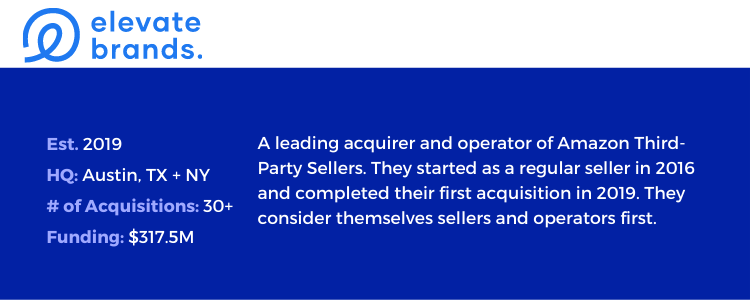
What is Elevate Brands looking for?
Elevate Brands targets high-quality, defensible Amazon private-label brands with category-leading review moats. Their target categories include: Arts & Crafts, Baby Products, Beauty & Personal Care, Grocery, Health & Household, Home & Kitchen, Office, Patio, Lawn, & Garden, Pet Supplies and Home Improvement
Their ideal acquisition target generates a minimum of $1M of annual revenue, with net EBITDA margins above 20%
What does Elevate Brands’ acquisition process look like?
Elevate Brands’ deal team ensures the underwriting process is seamless, efficient, and yields no unexpected surprises for the seller. During the 4-week diligence period, they analyze and verify your account health, quality of earnings, key revenue and expense drivers, assets (IP, inventory, working capital needs), and the supply chain. Additionally, they work with you to determine your desired role post-acquisition, if any, and if other employees will transition under the new ownership.
They typically complete additional work in advance of any LOI to ensure there are no surprises for you during the underwriting. Transactions are typically completed in 4 weeks from your first meeting to signing the legal documents and transferring funds.
If interested, you can learn more about Elevate Brands’ on their website.
4. SellerX
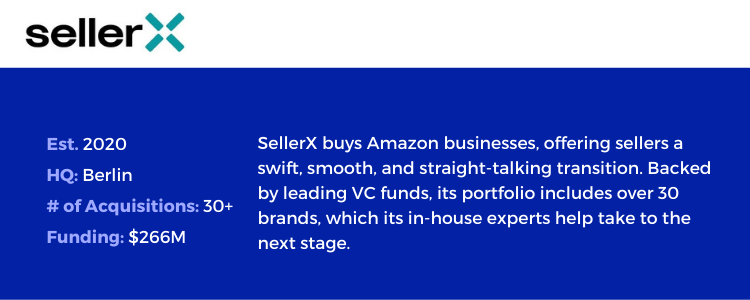
What is SellerX looking for?
SellerX looks for Amazon-native brands with a demonstrated track record of success and room for further growth through optimization or expansion initiatives ( new geographies, new channels, and new products). They are interested in brands with competitive and authentic reviews in their product niches (<4.3 stars). In addition, they tend to focus on enduring product categories where they see long-term sustainable demand and avoid products that can be perceived as “fads” or temporary in nature.
They generally acquire businesses that have reached a certain size threshold of ≥1M revenue and are growing quickly (≥30% year-over-year) with strong margin profiles (≥20% contribution margins).
What does SellerX’s acquisition process look like?
SellerX will set up a call that is designed for you to get to know SellerX, ask any questions you have and clear all doubts – they view it as an opportunity for them to understand your motivation and expectations and to see if it’s a good fit for both parties.
After the initial call they bring the opportunity to their Investment Committee, which meets every day. If they decide to move forward, they will do a deep dive into the financials and all other aspects of your brand. Based on the analysis, they typically send an LOI within a few days.
The acquisition timeline is guided by the seller. From a first call to submitting an LOI, they take up to one week and the due diligence process is 30-45 days.
SellerX is happy to connect with sellers regardless of their situation — whether you’re looking to sell now, for advice on an exit in the future, or even just curious about the valuation of your business. The best way to get in touch if you are interested is to visit their website.
5. Heroes Technology
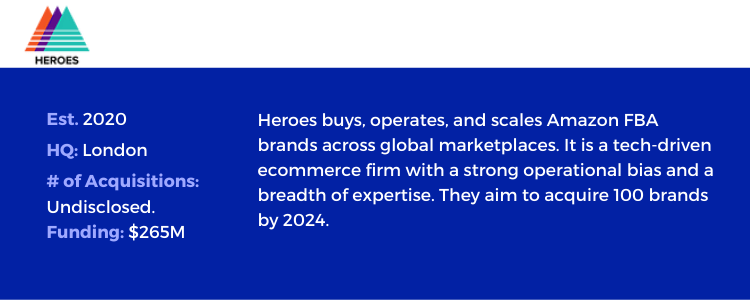
What is Heroes Technology looking for?
Heroes Technology focuses on Amazon FBA brands across a range of categories, all the way from Baby & Pet, to Home & Garden, to Fitness & Health. The ideal brand Heroes will invest in typically has a high number of outstanding customer reviews and a proven track record of bestseller listings in high-growth niches. They want to see consistency with signs of repeated purchases, upselling or cross-selling. They are interested in brands that generate between $500K-$20M in annual profits.
What does Heroes Technology’s acquisition process look like?
Selling your brand is an emotional step and Heroes Technology wants to make that process as enjoyable as possible by taking time to get to know you and your brand to provide a flexible offer. If and when you accept their offer, both parties sign an LOI and due diligence begins. Once this process is complete, the sale is finalized.
Selling your brand to Heroes typically takes 35 days from start to finish. However, they understand that selling a brand is a personal undertaking and will never pressure their sellers into a process or give short timelines to accept an offer. The fastest acquisition process for Heroes was a total of 6 days from signing an LOI to closing.
If you are an interested seller you can fill out a form on their website or book a call here. They have a multicultural team, so feel free to request a call in your local language.
6. HeyDay
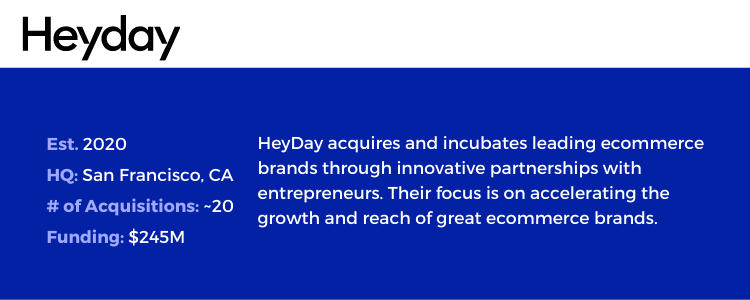
What is HeyDay looking for?
HeyDay acquires and incubates brands both on and off of Amazon. While Amazon is a major channel for them, Heyday’s brands are often extended to multi-channel businesses. They consider themselves fairly agnostic toward product categories – they focus on great brands that have differentiated products that appeal to customers while providing a clear value proposition.
They typically invest in brands that have achieved some degree of scale and have laid part of the groundwork to support significant investments. They primarily focus on brands with at least $5M of revenue.
What does HeyDay’s acquisition process look like?
HeyDay will work at the speed that you are most comfortable with, they can move quickly, but speed isn’t the primary focus. Close times can vary but when warranted, they can close a deal in under 30 days.
If you are an interested ecommerce brand you can inquire here.
7. Factory 14
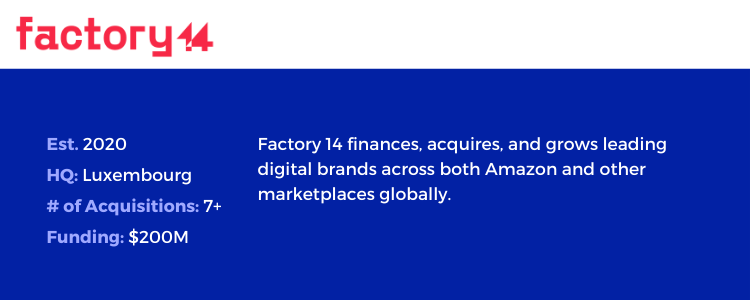
What is Factory 14 looking for?
Factory 14’s sweet spot is businesses that have high brand equity and/or a differentiated and unique product offering, with annual revenue between $1M-$25M. However, they also consider smaller businesses if they see high brand equity and excellent growth potential. They are particularly active in categories such as Sports & Fitness, Outdoors, Home & Kitchen, Home Improvement/DIY, Babies and Pets.
What does Factory 14’s acquisition process look like?
When you reach out to Factory 14, you will typically receive an answer within a day, with the next step being an initial meeting with the M&A team to introduce themselves and get to know your brand. If both sides are interested in moving forward, an NDA will be signed then Factory 14 will look at your brand’s financials, after which they submit a formal offer. This whole process can be as short as 48 hours.
If you accept the offer, you’ll sign an LOI and immediately start the due diligence phase, which typically lasts 20-30 days and is followed by completion of the sale. In most cases, founders continue working with them after closing to jointly take the brand to the next level.
Interested brands can contact Factory 14 on their website.
8. Moonshot Brands
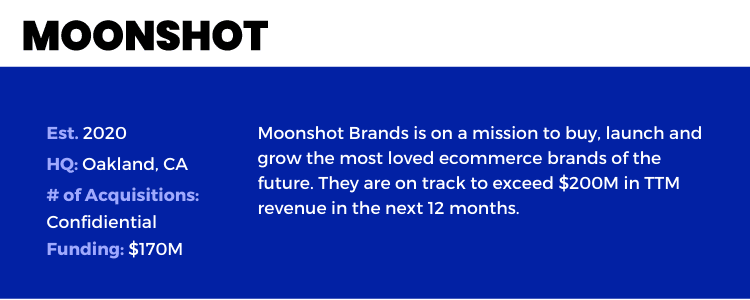
What is Moonshot Brands looking for?
Moonshot has a growing portfolio of companies, including The Cocktail Box Co, Magneto Boards, and Bustin Boards. All these brands have a strong omni channel presence across Amazon, DTC, and in retailers such as Target, Costco, and REI.
Moonshot Brands is primarily looking at brands in categories such as Home Goods, Pet Goods, Fitness, Outdoors, Games, and Beauty. They seek brands with strong financials generating between $2M-$30M in revenue with a strong potential to grow into category leaders.
What does Moonshot Brands’ acquisition process look like?
Moonshot Brands designed their process to be simple, fast, and painless. For a formal offer you can reach out to them and they will provide a valuation in 48 hours, make an offer within 72 hours, and close the deal in 35 days or less. They may also offer you a seat at the table to continue building your brand alongside them. They have many founders that continue to lead their companies with lucrative salaries.
If you are looking to sell your ecommerce business, the best way to reach out to Moonshot Brands is through this form on their website.
9. Olsam
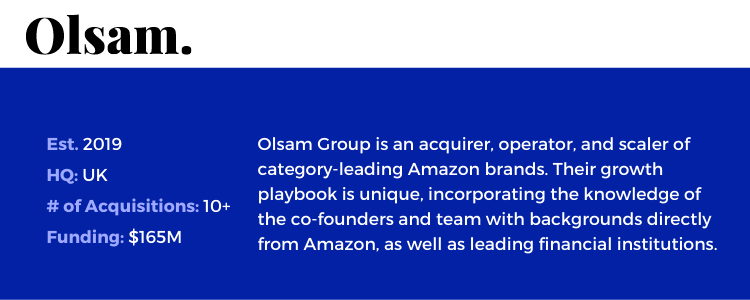
What is Olsam looking for?
Olsam looks for category leading brands across all marketplaces, with the majority of their revenue derived from Amazon. In addition, they focus on markets with evergreen and growth potential and avoid products that seem to be short-lived trends.
Oslam has found success with categories such as Homeware, Kitchen Products, Sports & Fitness, Baby, and Lifestyle. They currently avoid investing in categories such as Supplements, Perishables, Complex electronics, and some Apparel categories. They consider themselves fairly category agnostic but focus on strong review count, ratings and organic search rankings. They tend to target companies with revenue between $1M-$10M but will consider smaller or larger companies if the growth story fits.
What does Olsam’s acquisition process look like?
Olsam views acquiring your business as a partnership and wants you to look back in a year’s time and be proud of where Olsam has grown your brand, knowing that it was off the strong foundation that you gave them.
The initial discussion will be an introduction of both parties to learn more about each other. If both parties feel it is a good fit, you will enter into an NDA and perform their preliminary assessment and data analysis. Following this, they will provide a competitive offer. Once accepted, they will enter the Due Diligence phase where they review the financial, commercial and legal components of your business over a 3 – 4-week period. After all due diligence findings come back as expected, the transaction is closed and the funds are wired to your bank account. When all is said and done it is about a 6 week process.
Interested brands can reach out to Olsam via their website or schedule a call directly with one of their investment team members.
10. Acquco
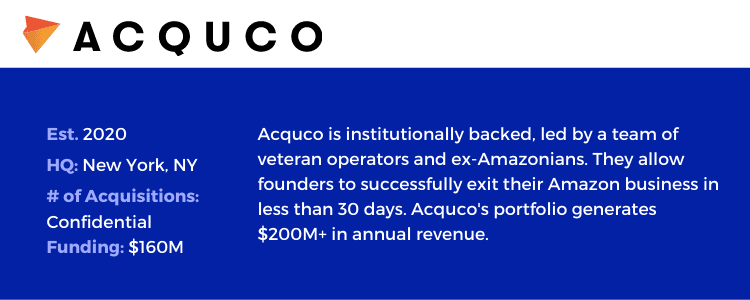
What is Acquco looking for?
Acquco typically seeks out larger brands with the goal of unlocking double digit to triple digit year over year growth. They are generally product agnostic, however they try to avoid fad products (ie. fidget spinners), heavy seasonality (ie. christmas trees), and products with obsolescence risk (ie. phone cases).
Acquco generally acquires brands with annual sales of $3M+, EBITDA margins above 20%, and positive YoY growth trends.
What does Acquco’s acquisition process look like?
Acquco has a six step acquisition process:
- You will speak with a member of their acquisition team –to answer high-level questions about your brand and determine if there is mutual interest.
- If there is mutual interest, they will request an NDA and basic financial information.
- Once those items are provided, they will give you a valuation within 48 hours and discuss deal terms.
- From there they can close on the deal in 30 days and have the funds ready to go.
- Once closed, they have built a seamless process that migrates your brand to Acquco’s platform, from brand management to supply chain, in as little as two weeks.
- Post-acquisition, they work with you on growth value drivers based on your experience in the marketplace and implement a broader proprietary growth playbook.
Acquco can close a deal within 30 days with a typical timeline that looks like this:
- Day 1 to 3 – 48 hours to get a valuation for your business from first outreach
- Day 3 to 21 – Sign LOI and conduct due diligence
- Day 21 to 30 – Fund and close the deal
If you are an interested seller, you can visit Acquco’s website for more information.
11. Suma Brands
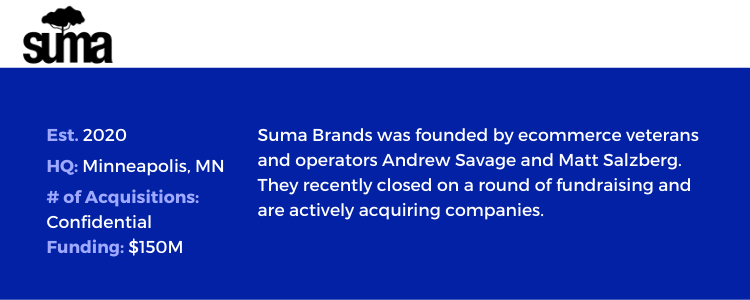
What is Suma Brands looking for?
Suma Brands looks for products with positive reviews and a multi-year track record of revenue and margin growth. They will consider any product category and any size business (with a minimum of $500K annual revenue), but prefer businesses with more than $1M in annual SDE.
What does Suma Brands’ acquisition process look like?
Suma Brands has a simple 3-step process for you to sell your Amazon brand, with a close time of 6 weeks or less.
- Introduction and data exchange
- Offer submission and due diligence
- Transaction execution and payday
If you are an interested seller you can fill out the intake form on their website.
12. D1 Brands

What is D1 Brands looking for?
D1 typically targets category-leading brands with high-quality, durable product catalogs and size-able review moats. Their ideal acquisition target is a private label brand doing at least $1.5M in annual revenue, with a primary focus on Amazon. They are category agnostic with some exceptions.
What does D1 Brands’ acquisition process look like?
D1 has a fast and thorough process with a 27 day average closing period, and a 100% close rate. They’ve built a system that combines hundreds of quantitative and qualitative metrics to empower their team to make high-conviction investment decisions quickly. Senior leaders lead & source all new opportunities, ensuring through a combination of data, experience, and authority that when they extend an offer it will get to the finish line. D1 understands that selling your business can be an intense and overwhelming experience so their team is available for sellers, from beginning to end, analyst to CEO, 24/7.
If interested, you can use D1 Brands’ contact form on their website.
13. Forum Brands

What is Forum Brands looking for?
Forum Brands looks for companies that are in large consumer markets that have trajectories that suggest they will be enduring markets 20 years from now. They look to acquire brands in which their resources and expertise can accelerate and sustain long-term growth. Some of the categories they prefer include Pet Products, Baby Products, Health & Personal Care, Home & Kitchen, Lawn & Garden, and Sports & Outdoors.
They look at the financial profiles of potential acquisitions holistically and generally aim for businesses generating greater than $1M in annual revenue. They are happy to consider smaller businesses if they have strong revenue growth, healthy margin profiles, limited seasonality, and annual net profit of at least $250k.
What does Forum Brands’ acquisition process look like?
Forum Brands will connect with you to learn about the story behind your brand and how Forum can help your brand with future growth. Then, they gather data and create a strategic partnership plan that shows Forum’s plans to grow and scale the business, this usually takes up to 48 hours. From there, they are able to close deals and provide you with meaningful cash payments within 30 days. You can expect a deal timeline built around your unique circumstances.
If interested, you can use Forum Brands’ contact form on their website. In addition, the Founder and Co-CEO, Ruben Amar, loves to speak with brand owners, and can be reached at [email protected]
14. Intrinsic
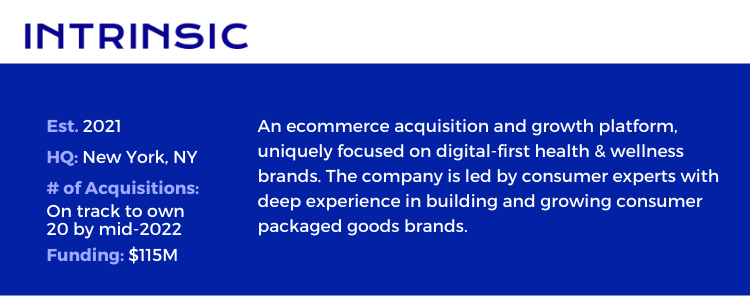
What is Intrinsic looking for?
Intrinsic is focused exclusively on Health & Wellness brands. They specialize in brands that address a specific health need and have between $500K-$10M in revenue, with a majority coming from the Amazon marketplace.
They are looking for brands with at least a 10% SDE margin. They typically require a minimum of $500K TTM revenue to consider an acquisition, but are open to learn about brands of all sizes. Their criteria on smaller brands is less focused on current size, and more around how they can use their expertise to grow the brand to at least $1M+ EBITDA in less than 12 months.
What does Intrinsic’s acquisition process look like?
The first step in their process is to get to know you and your vision for your brand. Instrinsic’s goal is to execute your brand vision and enable your products to reach more consumers.
If your brand aligns with their overall portfolio, and they believe they can execute your brand vision they will sign a LOI to acquire your brand. They work closely and quickly with you through the due diligence process to finalize the growth plan and close.
Intrinsic’s average closing time is 45 days, but it can take as little as 30 days if you are committed to moving quickly. Interested sellers can schedule a time to speak to one of Intrinsics experts by filling out this form.
15. Foundry Brands
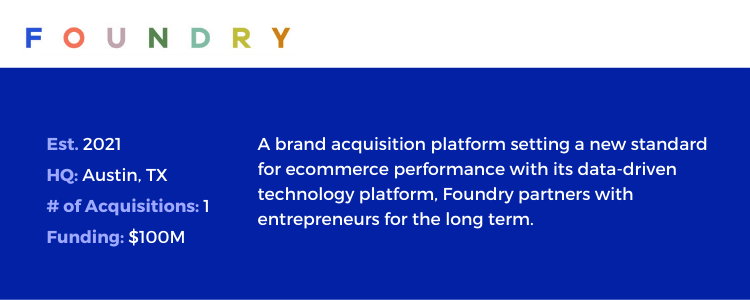
What is Foundry Brands looking for?
Foundry Brands is focused on enduring brands and ultimately, looking for businesses that have strong fundamentals where they can add their operational capabilities and resources to drive additional growth. Their capital structure allows them to consider brands of almost any size. They generally try to be open minded on having a floor as well and looking at the brand overall and the opportunities ahead to forecast value.
What does Foundry Brands’ acquisition process look like?
As a founder, Foundry Brands will spend time getting to know you to learn what you are hoping to accomplish with your exit and where you want to spend your time after you exit. This helps them define the right track for collaboration. After that, they will express their interest in pursuing your brand with a LOI and take time to understand your business prior to purchase.
Foundry Brands can close as quickly as a few weeks, with 30 days being the standard across the industry. Throughout the process their focus is ensuring that on day 1, post acquisition, they are already driving growth for your brand.
Interested brands can visit Foundry Brands’ website for additional information.
16. TCM Digital
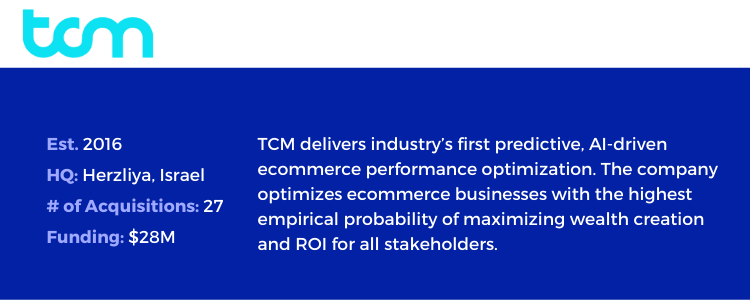
What is TCM Digital looking for?
TCM looks for businesses that are successful and undergoing growth but are not able to scale to the next level – the “hidden gems,” as they call it. TCM achieves this by applying its proprietary AI models that use big data, machine learning and deep learning to quickly evaluate trends and opportunities for e-commerce businesses and products. They look for Amazon brands that have a minimum annual revenue of $750K.
What does TCM Digitial’s acquisition process look like?
Once an e-commerce store is identified for acquisition, TCM immediately will provide you with precise analyses of your business value to facilitate smooth and fast acquisition transactions. When acquired, TCM’s Super Brain AI models also suggest potential growth vectors and forecast demand for products, brands and categories.
The transaction itself has 4 stages.
- Valuation determination by Super Brain.
- Offer discussion with Seller with LOI and/or Agreement.
- Deposit of agreed funds to escrow.
- Migration of assets and Closing.
Once your business is identified by Super Brain, deals can be negotiated and signed in as little as a few days. From start to finish the 4-stage process takes on average 3-4 weeks.
If interested, you can learn more about TCM Digital by visiting their website.
17. eBrands
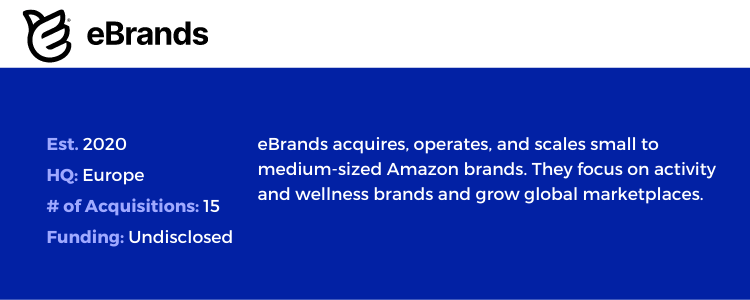
What is eBrands looking for?
eBrands looks for Amazon brands that fit their well-being strategy and have the potential to grow 100x. They focus on brands that are smaller (minimum $400K annual revenue in one marketplace, sub $3M) but operate in interesting niches. Ideal brands will only have a few SKUs.
What does eBrands’ acquisition process look like?
eBrands has a straightforward process and offers multiple deal models that are tailored to your specific needs. They will take a look at your business and then reach out for an official meeting. They prefer to develop a partnership with sellers and have had sellers join eBrands post acquisition. Under most deals eBrands will have the initial payment to you within one month from first engagement.
If interested, you can sign up through their website.
18. GOJA

What is GOJA looking for?
GOJA is an Amazon expert merchant and operator, so they target brands that derive most of their revenue from Amazon. They look for favorable market trends and other criteria such as size, growth, search volume, adjacencies to existing categories in their portfolio, and new categories they’ve strategically identified as important.
They strive to create a “win-win” for the seller and themselves and look for brands that generate at least $2M in annual revenue.
What does GOJA’s acquisition process look like?
GOJA’s 12 years of selling on Amazon helped them develop a straightforward, fast, and efficient process. Sellers start with one point of contact to take them through the initial steps. So, once you’re under NDA (non-disclosure agreement), it’s a smooth analysis of the brand’s financial and operational performance. Based on that, they align internally, decide if they wish to move forward, and present an LOI outlining deal terms for consideration.
GOJA is fast and efficient with a typical close in 30-45 days. Their capacity to seamlessly integrate and operate acquired brands means a stress-free post-acquisition.
If you are looking to sell your Amazon brand or would like to learn more you can visit their website.
What about using a broker?
If you are interested in exploring an exit from your Amazon business but don’t feel completely confident in the process, you could explore using a broker. A business broker will manage the entire acquisition process to accomplish a successful closing between you and the Amazon aggregator. This guidance will allow you to focus on running your business, reducing the risk of business erosion during the sales process.
Empire Flippers is a brokerage that offers a specialized marketplace for buying and selling online businesses. Continue reading to learn more about how they can help you tap into their buyer network to encourage their portfolio of aggregators to compete for your business.
19. Empire Flippers

What is Empire Flippers looking for?
Empire Flippers seek brands with steady or growing profit, multiple SKUS for revenue diversification, traffic diversification both on and off Amazon and overwhelming positive reviews.
As long as a brand is making over $1K average net profit per month over 12 months, they will look at the business as a potential asset. They have sold FBA businesses as small as $40k upwards to 8-figures. Their brokerage can handle all ranges of Amazon businesses from small side hustles to full blown enterprises.
What does Empire Flippers’ acquisition process look like?
The first step for interested sellers is to use Empire Flippers’ free valuation tool and provide them a general overview of what your business looks like. You will receive a valuation estimation based on real sales-backed data from deals they’ve sold on the marketplace.
After that, you can schedule an exit planning call with their team of business advisors. They will give you advice on whether you should sell or hold off from selling because they see an opportunity that could aggressively grow your valuation if given a few more months time to pursue. The acquisition process is an average of 28 days from the time your business is listed on their marketplace to the close of the deal.
Explore your options with Amazon aggregators
Depending on where you are at in your Amazon journey, you may or may not be ready to sell the ecommerce business you’ve built to an aggregator. Reaching out to one of the companies mentioned above is a great way to explore your options. If you’re looking to grow your business and increase profits in order to prepare your brand for a future acquisition, Jungle Scout has a wealth of seller tools that can help you get there!
Whatever you decide to do, Jungle Scout is here to support your growth and success on the Amazon channel!


 5 Comments
5 Comments
5 comments on “Want to Sell Your Amazon Business? These 19 Companies Are Interested”
Big thanks for sharing this incredible article! Looking forward for another article!
Thanks for reading!
Thank you for sharing this magnificent article!
Thanks Eva for sharing/ This is very informative!
Thank you Eva for this awesome blog! This is indeed very helpful!